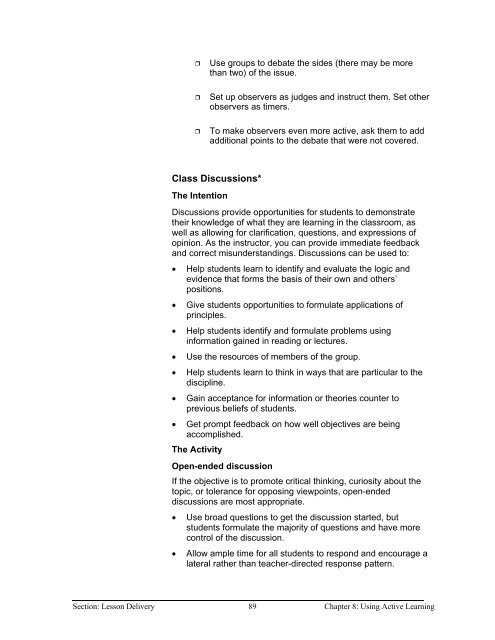Chapter 9 - Instructional Media: Chalkboards to Video - CGISS
Chapter 9 - Instructional Media: Chalkboards to Video - CGISS
Chapter 9 - Instructional Media: Chalkboards to Video - CGISS
You also want an ePaper? Increase the reach of your titles
YUMPU automatically turns print PDFs into web optimized ePapers that Google loves.
❒<br />
Use groups <strong>to</strong> debate the sides (there may be more<br />
than two) of the issue.<br />
❒<br />
Set up observers as judges and instruct them. Set other<br />
observers as timers.<br />
❒<br />
To make observers even more active, ask them <strong>to</strong> add<br />
additional points <strong>to</strong> the debate that were not covered.<br />
Class Discussions*<br />
The Intention<br />
Discussions provide opportunities for students <strong>to</strong> demonstrate<br />
their knowledge of what they are learning in the classroom, as<br />
well as allowing for clarification, questions, and expressions of<br />
opinion. As the instruc<strong>to</strong>r, you can provide immediate feedback<br />
and correct misunderstandings. Discussions can be used <strong>to</strong>:<br />
• Help students learn <strong>to</strong> identify and evaluate the logic and<br />
evidence that forms the basis of their own and others’<br />
positions.<br />
• Give students opportunities <strong>to</strong> formulate applications of<br />
principles.<br />
• Help students identify and formulate problems using<br />
information gained in reading or lectures.<br />
• Use the resources of members of the group.<br />
• Help students learn <strong>to</strong> think in ways that are particular <strong>to</strong> the<br />
discipline.<br />
• Gain acceptance for information or theories counter <strong>to</strong><br />
previous beliefs of students.<br />
• Get prompt feedback on how well objectives are being<br />
accomplished.<br />
The Activity<br />
Open-ended discussion<br />
If the objective is <strong>to</strong> promote critical thinking, curiosity about the<br />
<strong>to</strong>pic, or <strong>to</strong>lerance for opposing viewpoints, open-ended<br />
discussions are most appropriate.<br />
• Use broad questions <strong>to</strong> get the discussion started, but<br />
students formulate the majority of questions and have more<br />
control of the discussion.<br />
• Allow ample time for all students <strong>to</strong> respond and encourage a<br />
lateral rather than teacher-directed response pattern.<br />
Section: Lesson Delivery 89 <strong>Chapter</strong> 8: Using Active Learning
















